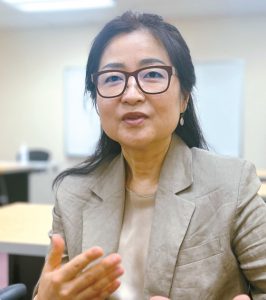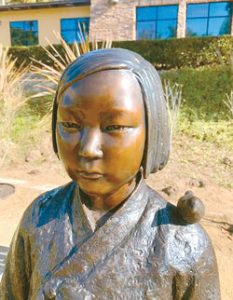
The Girl of Peace Statue in Glendale, symbolizing the “comfort woman,” a euphemism for the victims of Japanese wartime sexual slavery during World War II, will celebrate its 10th anniversary on July 30.
Out of the 240 registered victims of wartime sexual slavery, only nine “comfort women” survive, all in their 90s. Historians estimate that during the war, up to 200,000 women, mostly from Korea, were forced into frontline brothels for Japanese troops.
The unveiling of the statue holds profound meaning over time. Hyun-jung Kim (Comfort Women Action for Redress & Education – CARE), who played a key role in building the statue, shared its significance during an interview with the Korea Daily.
“The movement to build the statue of the comfort woman brought about an increase in the political power of the Korean American community in the United States,” said Kim.
“In particular, the passage of the comfort women’s resolution in the U.S. House of Representatives (H.Res.121), which was the trigger for the statue’s construction, was significant in that it was the first time Koreans (including Korean Americans) came together to achieve results in the mainstream political sphere.”
– What is the background of the Girl of Peace, or Comfort Woman, Statue?
“We have been trying to pass a comfort women-related resolution since 2000, but have been unsuccessful. At that time, the political power of the Korean American community was minimal. There was not even a grassroots movement. However, the passing of the Comfort Women’s Resolution in 2007, which was the cornerstone of the Girl’s Statue, was an event in which the Korean American community alone was able to accomplish something. That’s the before and after of grassroots activism in the Korean American community.”
– What has changed?
“Koreans became politically active through grassroots movements. Organizations such as the California Korean American Forum, the Center for Civic Engagement, and the Korean American Grassroots Conference were born. These movements spread across the country and led to the establishment of the Comfort Women Memorial and the Comfort Woman Statue.”
– Why did you choose Glendale?
“We sent letters to various city governments and organizations to request the site for a Comfort Woman Statue. We sent letters to over 100 places. We received responses from Cal State L.A. and others, but the city of Glendale was the most responsive. They had a lot of empathy with Armenian history.”
– What kind of resonance did the Comfort Women issue have with the city of Glendale?
“There are a lot of Armenians in the Glendale area. There is a lot of resentment towards Turkey because of the genocide in the past. The Turkish government continues to deny it, and I think there was a lot of empathy with the Armenians’ historical pain with the comfort women case in terms of the denial of history.”
– Was there a lot of opposition to the Comfort Woman Statue?
“When the news of the project was announced, more than 100 people of Japanese descent showed up at the public hearing. The opposition was so intense that I remember Mayor Frank Quintero, who was listening to the opposition, saying, ‘You don’t know because you’ve never been taught or learned about this history.'”
– There was also a lawsuit for demolition.
“It was a fight that lasted for three years after it was built. It was led by a USC professor (the late Koichi Mera). They brought in a big law firm. The intention was not to win, but to pressure us and send a warning message to other organizations that wanted to erect the Comfort Woman Statue. It ended up going all the way to the Federal Supreme Court. Fortunately, it ended when the Federal Court made the decision in favor of Koreans.
– What are your plans for publicizing the history of the Comfort Women?
“There are only nine grandmothers (comfort woman victims) left. We collaborated with Sogang University in South Korea to create an interactive video using artificial intelligence. We did long interviews with the grandmothers. We asked them questions, and A.I. picked out parts of the interviews to answer. The accuracy rate is 85%. We are working on increasing the accuracy of the answers to 95% by next year. We are also working on an English translation so that it can be used in the United States.”
– What is your current project?
“UCLA is creating a website archive for the history of Comfort Women. It will be completed by the end of this year. Starting next February, there will be an exhibit on the history of Comfort Women at the LA Museum of Social Justice. Scholarships for comfort Women’s history are also in place. A Korean American publisher has endowed scholarships at UCLA, the University of San Francisco, the University of Connecticut, Cal State L.A., Loyola Marymount University, and Vassar College. Each of these schools awards a $10,000 annual scholarship in the name of Comfort Women’s history to a professor or student.”

<Information about the 10th anniversary of the erection of the Comfort Woman Statue>
The 10th-anniversary event will be held on July 29 at 4 p.m. in front of the ARC building (201 E. Colorado St.), a Glendale community center. The Girl of Peace Statue was erected in Glendale on July 30, 2013, making it the first of its kind in the Western region. The first comfort women-related symbol (memorial) to be erected in the United States was on the grounds of the Palisades Park Library in New Jersey in 2010. In Glendale, a monument was originally planned. However, the Glendale City Council suggested that a statue of the girl be erected first so that the public could feel the historical significance, highlighting the deep historical ties between Koreans and Armenians.
BY YEOL JANG [jang.yeol@koreadaily.com]




